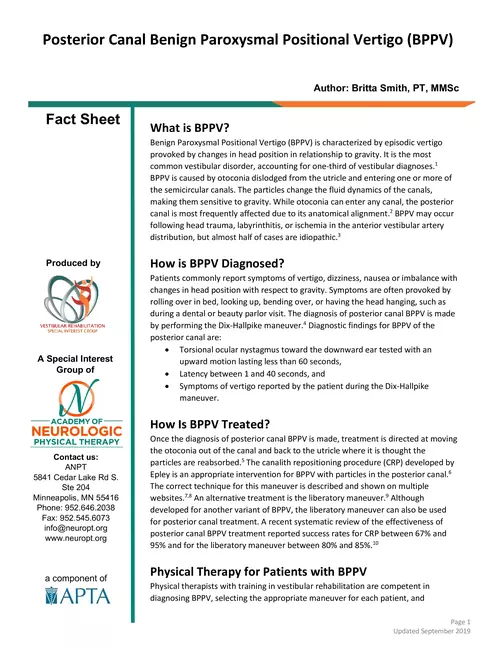
Posterior Canal Benign Paroxysmal Positional Vertigo (BPPV)
The symptoms of BPPV include dizziness or vertigo, lightheadedness, imbalance, and a video goggle. OFFICE TREATMENT OF BPPV: The Epley Maneuver.
adsPart of the document
a component of
Produced by
Fact Sheet What is BPPV?
Benign Paroxysmal Positional Vertigo (BPPV) is characterized by
episodic vertigo
provoked by changes in head position in relationship to gravity. It is the most
common vestibular disorder, accounting for one-third of vestibular diagnoses.
1
BPPV is caused by otoconia dislodged from the utricle and entering one or more of
the semicircular canals. The particles change the fluid dynamics of the canals,
making them sensitive to gravity. While otoconia can enter any canal, the posterior
canal is most frequently affected due to its anatomical alignment.2
BPPV may occur
followi
ng head trauma, labyrinthitis, or ischemia in the anterior vestibular artery
distribution, but almost half of cases are idiopathic.
3
How is BPPV Diagnosed?
Patients commonly report symptoms of vertigo, dizziness, nausea or imbalance with
changes in head position with respect to gravity. Symptoms are often provoked by
rolling over in bed, looking up, bending over, or having the head hanging, such as
during a dental or beauty parlor visit. The diagnosis of posterior canal BPPV is made
by performing the Dix-Hallpike maneuver.4
Diagnostic findings for BPPV of the
posterior canal are:
Torsional ocular nystagmus toward the downward ear tested with an
upward motion lasting less than 60 seconds,
Latency between 1 and 40 seconds, and
Symptoms of vertigo reported by the patient during the Dix-Hallpike
maneuver.
How Is BPPV Treated?
Once the diagnosis of posterior canal BPPV is made, treatment is directed at moving
the otoconia out of the canal and back to the utricle where it is thought the
particles are reabsorbed.
5
The canalith repositioning procedure (CRP) developed by
Epley is an appropriate intervention for BPPV with particles in the posterior canal.6


